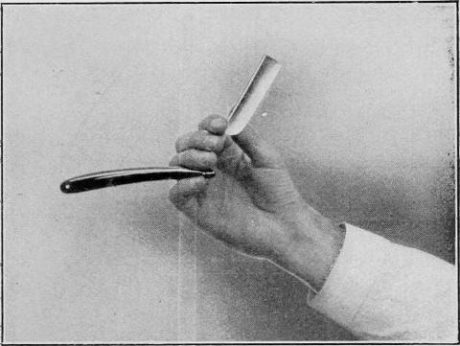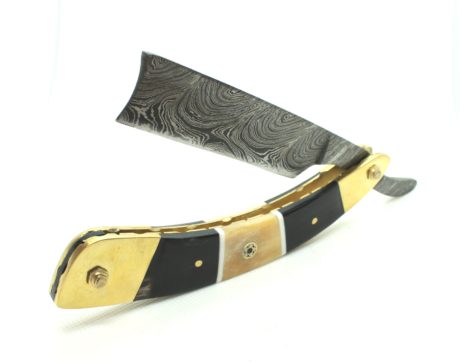When the safety razor first arrived on the scene just after the turn of the last century, it still took a great deal of time before the latest and greatest in shaving tech reached the broad market. In fact, a 1905 publication entitled Shaving Made Easy – What the Man Who Shaves Ought to Know published by the 20th Century Correspondence School barely makes a mention of the safety razor, favoring instead a focus on teaching men the proper methodologies for shaving with a traditional straight razor.
What follows here is a more general adaptation of the original instruction manual on how to shave with a straight razor. Today’s format is likely to be in the form of a video, but we thought it would prove helpful to recreate the basic outline of the guide using a bit of a modern flare.
Table of Contents
Selection of Your Shaving Tools
No matter the superiority of your shaving technique, poor shaves most frequently derive from inferior tools. Poor shaving results are most often the result of low quality razors, strops and accouterments. The best quality shaves include two parts hardware/product and one part technique.
The best shaving set-up will include at least one (and often two–for quick swap-outs) straight razors, a quality strop and the knowledge to properly use them. Great results are the proper combination of both good technique and quality, artisan tools.
When it comes to the hardware for your daily shave routine, here are some considerations to add to your list of “must haves” and “nice to have”.
Must Haves:
- A Straight Razor
- A Razor Strop
- A Mirror
- A Cup or Bowl
- A Shave Brush
- Shaving Soap or Cream
- A Bottle of Bay Rum or Witch Hazel
- Aftershave or Face Lotion
Nice to Haves:
- A Razor Hone
- Talcum or Magnesia Powder
- Styptic Pencil or Astringent Pencil
- Antiseptic Lotions
While some of these items are more critical than others, each has its place in the process of obtaining the best quality straight razor shave.
The Straight Razor
The most critical component of your shaving hardware is the razor. The success or failure of your straight razor shave will be highly dependent on the quality of the razor you choose. When it comes to choosing a straight razor, being overly cost-conscious can be detrimental to the quality of your shave. With a safety razor, the quality of the shave is more often dependent on the razor blade and/or the overall quality of the blade setting on the razor blade head. Not so with a straight razor. Your razor’s ability to hold a good edge is more important than most newly-minted straight razor shavers realize.

A standard straight razor
The most critical component of your straight razor selection process will be finding a straight razor with the highest-quality steel possible. Inferior steel will hold an inferior edge, an inferior edge will produce a sore face post-shave. The wrong razor will be a continual source of annoyance, requiring you to go back to the market and invest in a completely new straight razor–not the ideal scenario.
Do yourself a favor, do not go for the cheapest. Source the best.
A razor made from quality steel will undoubtedly produce a quality shave year-after-year, strop-after-strop. But, when it comes to choosing a straight razor, how do you select one made from quality, tempered steel that will hold a solid edge for a lifetime without testing it and directly using it? In most cases, the naked eye (and especially some random internet site) may not provide sufficient information. Furthermore, and even more injurious (literally) is the fact that slight irregularities in the edge of the razor and lack of proper tempering can add to the razor’s friction against the face and produce higher levels of irritation, especially on those with thinner, more sensitive skin to start.
The only real way to test whether a razor’s edge is not only adequate but produces the quality shave you might expect from a straight razor is to 1) shave with it more than once or 2) examine it under a microscope. Because both are nigh to impossible
What makes this process of choosing a straight razor even more difficult is the fact that most beginning straight razor wet shavers may not even know what to look for (i.e. even if they did shave or if they were to look at the razor under a microscope, their lack of knowledge in knowing what to look for will be detrimental in making a good decision).
It will be readily admitted that the real excellence of a razor is in direct proportion to the firmness and unbroken regularity of its edge.
During the razor heating and tempering process, there are many mistake-making opportunities that can affect the quality of the blade. For instance, if the blade is heated too much during the steel hardening phase, the steel can become too brittle. If it is not sufficiently cooled in the tempering phase, there is a lower likelihood it will hold a quality cutting edge, regardless of the effort put into honing and stropping. A skillful and knowledgeable shave-smith will be able to see such flaws under the glance of a microscope, but the eye of a neophyte is more likely to miss it.
Quick Tip–Simple Method for Testing the Quality of Razor Blade Tempering: Catch the point of the blade under the nail of the thumb and then let the nail slip off quickly. If the blade provides good “feedback” in the form of a nice ring sound, it is safe to conclude the blade has been well-tempered. If not ring occurs, then that is a strong sign the blade has not be tempered evenly.
Razor Blade Concavity
When it comes to the gauging the sharpness of the edge of a straight razor, the thickness of the edge matters. The thinner the edge, the sharper the blade and the better the cut. Consequently, the goal of most experienced straight razor shavers is to source a straight razor whose edge is as thin as possible, given what the composing metal may permit. Most straight razors are now made of “hollow ground” or “concave” structures. Concave blades include thinner edges which are easier to keep sharp.
Higher concavity of the blade will also allow the blade to “sing.” That is, concave blades produce a hollow ringing feedback sound as they cut through whiskers. This feedback is often music to the ears of those who thoroughly enjoy a straight razor shave. But not all blade concavity is created equal. There are three degrees of straight razor blade concavity:
- Half Concave.
- 3/4 Concave.
- Full Concave.
Full concavity is the thinnest and (based on our previous discussion) the sharpest. While this might lead you to conclude that a full concave blade is the best for all situations, you would be mistaken. It can be less effective in the event that you are shaving a full beard. A thick, course beard will provide more push-back on the more hollow blade, causing it to flex and bend.
Yes, there is more overall sharpness, but hacking through a large bearded mane will likely require you to both increase the angle of your shave as well as the pressure, which can lead to a nice bloody wound. For thicker beards, it is best done using a thicker and less concave razor.
Razor Blade Width
A razor blade’s thickness can also be influenced by the corresponding width of the blade. In many cases, beginner shavers typically select a blade that is much too wide for starting out. Something middle-of-the-road in terms of width–perhaps 4/8 (see below for corresponding image)–should be sufficient to provide the control required to become truly proficient at shaving with a straight razor. Narrower blades offer more control to the shaver as they follow the contours of the face more closely.
Blade Point
The end of the blade is the most critical component when it comes to avoiding cuts. Round-cornered blades provide more protection against the occasional cut or nick. See corresponding images below for an example of both the round-pointed blade and the sharp-pointed blade.
The end of the sharp-pointed blade can be ground-down with ease using your hone. When doing so, be sure to use a side of the hone that is not typically used when performing a hone on the blade edge itself. If you use the hone’s main surface, there is a high likelihood of scoring the hone. A scored hone is useless in providing an even solution to honing your razor.
Additionally, rounding the straight razor using the hone should be done with ample water. Excluding water has the potential of overheating the blade and screwing up the blade’s temper.

A round-pointed straight razor blade

A sharp-pointed straight razor blade
Not every straight razor is ideal for every shaver. Beginners are best served with one type of blade, whereas experienced straight razor shavers may be served best with another. The type of hair, sensitivity of the skin and other factors can contribute to the overall decision as to what blade makes the most sense under your circumstances.

